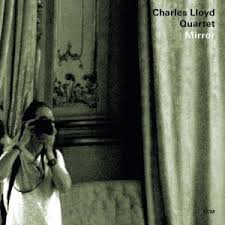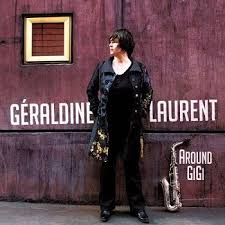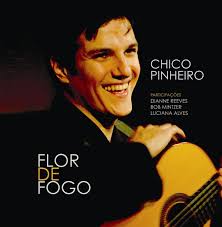CHARLES LLOYD QUARTET
Mirror
 By John Kelman
By John Kelman
Sometimes the trust in knowing can yield more than the excitement of uncharted territory. Charles Lloyd ratchets down the energy from Rabo De Nube (ECM, 2008), one of the most exciting, free-wheeling albums and new groups of the saxophonist's half century career. Relying on the quartet's increasingly profound chemistry--and mostly recycled material rather than Rabo's largely new set of originals--Lloyd continues his upward trajectory; his intrinsically spiritual nature a moving force behind an album somewhat reminiscent of The Water is Wide (ECM, 2000). The Water is Wide's multigenerational quintet of established greats and stars-in-the-making, however, culled low-keyed material from a longer recording session that also yielded the energetic follow-up, Hyperion with Higgins (ECM, 2001). Instead, Mirror teams Lloyd with three active, thirty-something musicians on the vanguard of 21st Century American jazz.
Garnering plenty of attention for his own records, Jason Moran has proven an even more astute sideman, in particular for his recent work with Lloyd and ECM label-mate Paul Motian, whose Lost in a Dream (2010), shed new light on the pianist's mélange of Monk-ian angularity, free-wheeling improvisational extremes, and lyrical impressionism. He brings the same sensibility to Mirror, but its general emphasis on ballads, and ambling swing creates a different set of extemporaneous demands, though he does fly into more outré space on a far more powerful and open-ended version of the traditional “Lift Every Voice and Sing” than on Lift Every Voice (ECM, 2002), and “Being and Becoming,” from Which Way is East (ECM, 2004), Lloyd's intimate duo album with Billy Higgins, recorded shortly before the iconic drummer's passing in 2001.
Positioned near Mirror's conclusion, these tracks contrast powerfully with Lloyd's title track--originally on his 1989 ECM debut, Fish Out of Water, but delivered here with a touch more energy and plenty more commitment--and an equally direct look at “Desolation Sound,” from Canto (ECM, 1994). Throughout Lloyd's previously visited originals, traditional spirituals (The Water is Wide's title track, here, going straight to church) and standards, Harland and bassist Reuben Rogers propel the music with more egalitarian interest. Two Monk tunes--the balladic “Ruby, My Dear” and rubato “Monk's Mood”--demonstrate Moran's inescapable roots, while Lloyd turns “Caroline, No,” from The Beach Boys' classic Pet Sounds (Capitol, 1966), into a thing of simmering beauty.
Saving the best for last, Lloyd's gentle narration on Which Way is East's “Tagi”--layered over a backdrop of Rogers' arco and Moran's impressionistic pianism--is nothing short of transcendental. Ebbing and flowing with spiritual profundity, Lloyd turns to saxophone for a modal solo driven by Harland's intensifying pulse, before the quartet dissolves for a tranquil coda, bringing Mirror full circle.
While not turning entirely away from the Rabo De Nube's unfettered freedom, Mirror's greatest success is its quartet's palpably growing sense of trust, allowing the freedom to explore without the compulsion to resort to the obvious or the melodramatic. Instead, the smallest gestures become amplified, as Mirror continues to bolster Lloyd's latest ensemble as one of the best--and certainly the freest--of his long career.
Track Listing: I Fall in Love Too Easily (For Lily); Go Down Moses; Desolation Sound; La Llorona; Caroline, No; Monk's Mood; Mirror; Ruby, My Dear; The Water is Wide; Life Every Voice and Sing; Being and Becoming, Road to Dakshineswar With Sangeeta; Tagi.
Personnel: Charles Lloyd: tenor and alto saxophones, voice; Jason Moran: piano; Reuben Rogers: bass; Eric Harland: drums.
YARON HERMAN TRIO
Follow The White Rabbit
 By Bruce Lindsay
By Bruce Lindsay
Follow The White Rabbit is Israeli pianist Yaron Herman's fifth album--his first on the ACT label and his first with the rhythm section of bassist Chris Tordini and drummer Tommy Crane. Continuing the format of his past trio albums A Time For Everything (Laborie Records, 2007) and Muse (Laborie Records, 2009), Herman mixes original tunes and covers, including one or two unusual and not altogether successful choices.
Radiohead's “No Surprises” keeps close to the sound of the original: Herman's piano replicates Thom Yorke's vocal line but, without Yorke's emotional intensity, the whole becomes rather saccharine. No surprises, indeed. Kurt Cobain's “Heart Shaped Box” is given a similar treatment, but Crane's drumming is in stark and welcome contrast to Dave Grohl's on the Nirvana original and Herman's piano gives the tune a smoother and more lyrical feel, to replace Cobain's anger with sadness. Frank Churchill's “Baby Mine,” from Dumbo (1941), gets a respectfully delicate treatment, but even without its lyrics the song is still cloyingly sentimental.
Herman's own compositions have an impressive maturity and range. “Cadenza” is a solo piano piece, beginning firmly in a classical style but opening out and becoming freer in its latter stages. “Airlines” starts as a mid-tempo tune with a rolling, fluid melody before it builds in intensity as first Tordini and then Herman deliver impressive solos. “Aladins (sic) Psychedelic Lamp” opens with dramatic piano chords but soon shifts gear to a softer and more reflective vibe. Crane and Tordini give “Clusterphobic” a gentle funkiness over which Herman creates an expansive and rich melody.
”Follow the White Rabbit,” a trio composition, is a beautiful track featuring superb ensemble playing. In fact, the album's real strength is the quality of the trio's ensemble playing--Tordini and Crane are as crucial to the success of the music as Herman, even if Crane occasionally pushes a bit too hard, on “Trylon” or “The Mountain in G Minor” for example.
Herman has routinely been compared to Keith Jarrett and Brad Mehldau. This new trio line-up brings him closer to European contemporaries such as the Kit Downes or Tord Gustavsen trios--inventive yet melodic groups whose distinctive sound comes as much from the bass and drums as it does from the piano. His biography claims that he's “an exceptional phenomenon, unique in the history of piano playing”--that's pushing things a bit too far, but he is certainly an impressive player and writer and Follow The White Rabbit is the product of a fine new Trio.
Track Listing: Follow the White Rabbit; Saturn Returns; Trylon; Heart Shaped Box; Ein Gedi; The Mountain in G Minor; Cadenza; Airlines; Aladin's Psychedelic Lamp; Baby Mine; White Rabbit Robot; Clusterphobic; Wonderland; No Surprises.
Personnel: Yaron Herman: piano; Chris Tordini: double bass; Tommy Crane: drums.
GÉRALDINE LAURENT
Time Out Trio
 by Claudio Botelho
by Claudio Botelho
Her name is Géraldine Laurent and she plays the alto sax. Along with her cohorts, bassist Yoni Zelnik and drummer Laurent Bataille, she has recorded a work reminiscent of some two other that come to my mind: “Trio Jeepy” by Brandford Marsalis and “The State of the Tenor” by the great late Joe Henderson. Well, here we don’t have a tenor sax, as much as a player of similar stature, but, at least, her group seems as cohesive. She plays an alto sax. Definitively, not a me too sax player, as her “Time Out Trio”shows from its first notes.
For me, Jazz is essentially a masculine art. I have met very few females who really appreciate this subject. The reason is a great mystery. If anybody has any hunch… Anyway, from time to time, there appears some surprise.
The recording comprises some well known American standards as opposed to some lesser known jazz tunes. There’s, also, one original of hers. The jazz composers range from Wayne Shorter to Ornette Coleman. The first, one of the all time bests, the second another mystery for me, as I could never understand the popularity of many of his no-second-part-sterile-tunes.
How can anyone compares “Rejoicing” to “I Fall in Love too Easily”and put them side-to-side in a single offer? It’s beyond me. Anyway, the musicians should know better and certainly found, in his compositions, secrets I can’t see…
Nevertheless, jazz is an instant art and, even without the help of an inspired song (in my view, of course), an improviser of Laurent’s caliber can make gold out of junk…
The recording is comprised of ten songs and lasts circa fifty minutes which flow faster than this number suggests: the songs are densely worked and the listener have no time to be impatient: there’s no dispensable improvisations as the players are highly integrated and, so, there are no meaningless waste-of-time solos. The renderings are always compact and full of meaning. And there’s a surprise Mr. Wayne Shorter never told: Lester wasn’t all that much decided to leave the town! Check!...
By Chris May
Formidable, as her compatriots would say. Time Out Trio, the debut album from young French saxophonist Geraldine Laurent, introduces a bare knuckle force of nature, well-versed in the jazz tradition but not afraid to put her own abandoned spin on it. Rough-edged, risk-taking, high octane, totally in the moment, the music bursts out of the speakers like a hurricane.
Laurent's alto playing is rooted in Charlie Parker, his wild, sometimes squawking, clattering attack played with a slightly softer read and with a narrower embouchure, but still well tough. Other voices echo round the edges: alto saxophonists Ornette Coleman, Cannonball Adderley and Joe Harriott. And occasionally, on the infrequent ballad, the divine Paul Desmond. But most of the time, Laurent, who's on-mic for practically the entire 47 minutes of the album, just wails.
Recorded in a Paris studio in December 2006, Time Out Trio has an in-your-face, warts-and-all, lo-fi live sound, brilliantly suited to Laurent's gutsy style. There are nine standards and one original, and it's surely no coincidence that two of the tunes are by bassist and bandleader Charles Mingus, whose turbulent spirit resonates here. The longest track, a seven-plus minute head-charge through Mingus' ferocious “Fables Of Faubus,” is outstanding. Laurent romps through the tune and an extended solo paying full homage to reed player Eric Dolphy's signature, incandescent reading on Charles Mingus Presents Charles Mingus (Candid, 1960), avoiding the tortured outer extremes of Dolphy's vocalizations, yet communicating plenty of her own rebel passion. Mingus, you sense, would have loved it.
Other standouts--though there isn't one dud on the set--include dynamic readings of Wayne Shorter's “Lester Left Town” and Hoagy Carmichael's “Skylark,” and Laurent's own “A Quiet,” which is a soft, wistful ballad before the gas gets turned up.
Laurent is perfectly matched by her colleagues, bassist Yoni Zelnik and drummer Laurent Bataille. Both stand toe-to-toe alongside her throughout, and Mingus analogies continue to suggest themselves. Zelnik plays with the same muscle and abandon, Bataille with the confrontational zeal of the great man's favorite drummer, Danny Richmond. Most of the time, they work the engine room--Zelnik with a mixture of ostinatos and free flourishes, Bataille in call-and -response--and each thrills on his couple of brief solos.
This is an extraordinary debut album, and Geraldine Laurent is a gale force blast of good news.
Track Listing: Autumn Nocturne; Lester Left Town; I Fall In Love Too Easily; Rejoicing; Skylark; Fables Of Faubus; A Quiet; Repeat; Tijuana Gift Shop; Love Letters.
Personnel: Geraldine Laurent: alto saxophone; Yoni Zelnik: bass; Laurent Bataille: drums.
GÉRALDINE LAURENT
Around GiGi
 by Dreyfus Records
by Dreyfus Records
Que vous soyez simple mélomane (littéralement : amoureux de mélodies) ou jazzfan averti, voici un disque qui a tout pour vous séduire – une telle occasion de faire l’unanimité sans céder à la facilité est trop rare pour ne pas être soulignée.
La seule lecture des titres sélectionnés en témoigne : la saxophoniste Géraldine Laurent a choisi quatre thèmes de sa plume et, surtout, six compositions signées (créées dans les premières années cinquante) par le saxophoniste Gigi Gryce, le trompettiste Art Farmer et le pianiste Thelonious Monk. Trois sculpteurs de musique, trois défricheurs singuliers pour qui, s’il n’avait pas existé, le mot originalité aurait dû être inventé !
Autant dire qu’il s’agit là d’explorer ou de redécouvrir des chefs d’œuvre inespérés :
Gallop’s Gallop, par exemple, est un irrésistible clin d’œil (1’43 de dialogue entre la saxophoniste et le batteur Franck Agulhon) à ce bibelot monkien que Thelonious lui-même enregistra d’abord au sein du quartette de Gryce ; écrit en 1953 par Art Farmer, l’un des plus doux tisseurs de mélodies que le bebop ait révélé, Mau Mau (allusion à la guerilla d’indépendance qui avait embrasé le Kenya un an plus tôt) évoque une Afrique fantasmée et peut-être idéale.
Quant à Kerry Dance, Minority, Nicas’s Tempo et Smoke Signal, ils forment une manière de bouquet, hommage du quartette réuni par la saxophoniste à cet illustre méconnu entré dans la légende du jazz.
Né George General Grice le 28 novembre 1925 à Pensacola (Floride) et devenu, plus brièvement, “Gigi” Gryce, il allait disparaître en 1983 avec pour seule consolation d’avoir impressionné ses confrères, de Monk à Coltrane en passant par Stan Getz et Dizzy Gillespie, autant par la délicatesse de son jeu de saxophone que par son talent d’écriture.
Soit une constellation de joyaux mélodiques littéralement inouïs, travaillés et peaufinés par la saxophoniste comme on taille des diamants !
Et, au fil des plages, un large éventail d’émotions et de surprises, car Géraldine Laurent, encore une fois, fait preuve de cette virtuosité amoureuse indissociable d’une mémoire vive qui, par la grâce d’une relecture superbement et rythmiquement personnelle, lui permet de trouver des chemins toujours nouveaux.
D’emblée, le ton (le groove !) est donné : entourée de trois maîtres ès tempo, dont l’indéfectible et élastique Yoni Zelnik et le non moins talentueux Pierre de Bethman, l’altiste (que l’on avait pu entendre dans les contextes et lieux les plus divers, jusqu’à son mémorable Time Out Trio et au “Just Jazz” d’Aldo Romano) slalome au gré des « portes » harmoniques avec ce mélange d’agressivité (en jazz on parle d’attaque), de rapidité et d’agilité qui marque les grands improvisateurs. Ou quand l’histoire et l’actualité s’entrelacent afin que jaillisse une musique constamment neuve.
CHICO PINHEIRO
There´s A Storm Inside / Flor De Fogo

 by Dr. Leo Rocha
by Dr. Leo Rocha
Bastante aguardado e elogiado pela mídia,sinceramente, não chegou a me entusiasmar como esperava que acontecesse. É claro que adoro o Chico Pinheiro pois conheço todos os seus discos anteriores a esse,incluindo o maravilhoso "Nova" que ele divide com o guitarrista fenomenal Anthony Wilson. Foi tão grande o estardalhaço da mídia que me apressei e comprei logo o disco importado sem saber que em seguida já seria lançado em edição brasileira com o nome de "Flor de Fogo" e com outra capa.
Chico resolveu agora, intensificar mais ainda o seu lado de cantor,que ,é bom frisar, muito agradável,embora eu prefira a sua porção violonística (ou guitarrística,se preferem). Está muito bem acompanhado de músicos talentosos como:Paulo Calasans(acoustic piano), Paulo Pauleli(bass), Edu Ribeiro(drums), Fabio Torres(piano), Marcelo Mariano(bass), Marcos Bosco(percussion),Lula Alencar(accordion), Zé Pitoco(zabumba),Marcos Spirito(ganzá), além das participações especialíssimas de Dianne Reeves(vocals), Bob Mintzer(tenor sax and bass clarinet), Luciana Alves(vocals) e Proveta (clarinet). Portanto, um time de primeira,mas parece que o "negócio não explode" e fica "sem decolar". Apesar da primeira faixa ser uma música muito bonita, não houve nada criativo ,nada de novo na releitura de "Our love is here to stay". "Boca de siri" é legal e faz-nos lembrar a música de João Bosco e Aldir Blanc com um belo solo de violão do Chico. "There's a storm inside" apresenta um inspirado solo de piano por Fábio Torres e a participação vocal de Dianne Reeves que não acrescenta nada demais. "Recriando a criação",uma das melhores, é de autoria de Chico em parceria com Paulo Cesar Pinheiro; trata-se de um lindo tema que foi brindado com o toque de violão de mestre do dono do disco (aí, sim !). Outro tema muito bonito é "A sul do teu olhar" interpretado por Luciana Alves como também "Um filme", de acento bossanovístico. Chico Pinheiro ainda dá um tremendo show em sua guitarra em "Sertão Wi Fi". Uma sessão de cordas ainda se faz presente em algumas faixas. Enfim,uma produção cara que poderia render muito mais. Chico fica devendo um outro.
Léo, esse garoto ainda vai longe!!!



